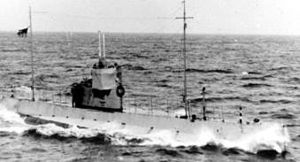HMCS CC-1

HMCS CC-1 underway on surface
|
|
| History | |
|---|---|
|
|
|
| Name: | CC-1 |
| Builder: | Seattle Construction and Drydock Company |
| Launched: | 3 June 1913 |
| Acquired: | 4 August 1914 |
| Commissioned: | 6 August 1914 |
| Fate: | Paid off in 1920, broken up 1925 |
| General characteristics | |
| Type: | CC-class submarine |
| Displacement: |
|
| Length: | 144 ft (44 m) |
| Beam: | 15 ft (4.6 m) |
| Draught: | 11 ft (3.4 m) |
| Propulsion: | MAN 6-cylinder diesel engine |
| Speed: | 13 knots (24 km/h; 15 mph) |
| Test depth: | 200 ft (61 m) |
| Complement: | 18 (2 officers, 16 enlisted) |
| Armament: | 5 × 18 in (457 mm) torpedo tubes |
HMCS CC-1 was a CC-class submarine used by the Royal Canadian Navy. Acquired by British Columbia at the outbreak of the First World War, the ship had been initially built for Chile as Iquique. However, after a dispute with the shipyard, Chile refused the submarine and the shipyard owners sold the vessel to Canada instead. Renamed CC-1 in Canadian service, the vessel was commissioned in 1914 and remained active through the war. Following the war, the submarine was laid up and was discarded in 1920.
Differing from her sister boat, CC-2, CC-1 was built to the design 19E. The layout of the torpedo tubes within the boats led to different hull forms. CC-1 was armed with five 18 in (460 mm) torpedo tubes, four forward and one astern. This gave the submarine a bluff bow shape. The submarine used Whitehead Mk IV 18-inch (460 mm) torpedoes that had a range of 1,000 yd (910 m) at 25 kn (46 km/h; 29 mph). The only source for these torpedoes in Canada was HMCS Niobe's stock and it took some time before they were shipped to the submarines.
CC-1 displaced 313 long tons (318 t) surfaced and 373 long tons (379 t) submerged and had a length of 144.5 ft (44.0 m), a beam of 15 ft (4.6 m) and a draught of 11 ft (3.4 m). The boats could dive 200 ft (61 m) and unlike modern submarines, the main ballast and trim tanks were located internally. The boats were powered by MAN 6-cylinder diesel engines constructed in the United States under licence. The CC class could carry 5,356 US gal (20,270 l) of diesel fuel. The two submarines were designed to make 13 knots (24 km/h; 15 mph) surfaced and 10 knots (19 km/h; 12 mph) submerged, however CC-1 made 15 knots (28 km/h; 17 mph) in sea trials in November 1917. The submarine had a complement of 2 officers and 16 enlisted.
...
Wikipedia
